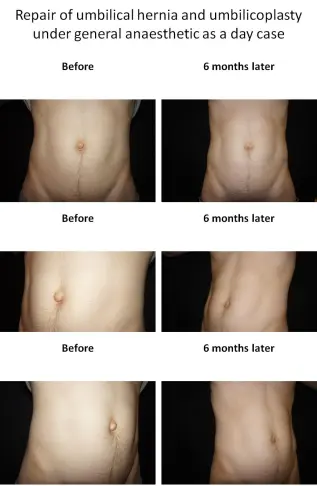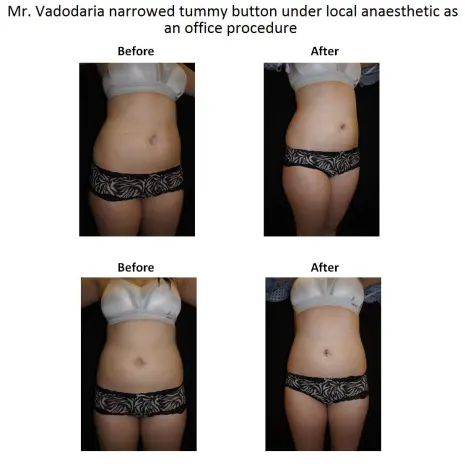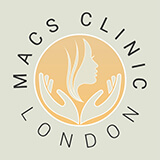
Reshaping your tummy button- Umbilicoplasty
‘Umbilicus’ refers to the belly button and ‘plasty’ has connotations of the grafting, reconstruction or formation of something. The umbilicus (belly button) is formed at birth by the scar left by the umbilical cord that was fundamental in keeping you alive when you were in your mother’s womb. Traditionally, the scar left from cutting the umbilical cord is of two kinds: either an ‘innie’ or an ‘outie’ hence explaining why we find navel buttons of a variety of different shapes, depths and sizes. There is a significant amount of variation in the size, shape, depth and location of the umbilicus depending upon ethnicity, the tone of the adjoining muscles, distribution of fat into surrounding area and the after effects of pregnancy depending on how the midwife cuts off the umbilical cord.
Why Have an Umbilicoplasty ?
Umbilicoplasty is becoming increasingly more popular. As a result of how fashion has changed, women now tend to wear low cut skirts and crop tops in the summer which expose the belly button, therefore one may like to change the shape of their umbilicus if they fear that it is of an unusual shape or size. Generally speaking, an ‘innie’ is found more attractive than an ‘outie’ due to its smaller and tighter appearance. Other common reasons for wanting an umbilicoplasty include :
- No belly button at all or a badly shaped navel from birth, or as a result of some sort of trauma or faulty surgery in the past
- A small hernia which may stick out in a little lump next to the belly button
- Flat- or elongated navels which some people like to have made rounder. It is believed that a circular belly button has a younger look to it than a longer, flatter kind
- A belly button that is shifted to one side, sticks out, or is hidden by folds of flesh or wrinkles.
In Indian culture, as listed in Kama Sutra, the navel is seen as a sexual symbol which is often touched by the male in sexual foreplay and therefore some women will want an umbilicoplasty in order to make their navel as sexually appealing as possible.
Fortunately, an increasing amount of plastic surgeons are now offering this relatively straightforward procedure which in recent years has grown in demand. Anyone considering an umbilicoplasty should contact Mr Vadodaria’s office to book an one hour consultation.
Pre-Operative Care Before the operation, make sure you follow these rules:
- Do not have anything to eat or drink for at least 6 hours prior to your surgery.
- Stop smoking for a period of 2 weeks before and 2 weeks after surgery.
- Stop Alcohol 1 week prior to surgery.
- Avoid the following oral preparations at least 2 weeks prior to and 2 weeks after surgery:
Any mixture containing
- Vitamin E
- Effamol G
- Evening Primrose Oil
- Salmon Oil
- Codliver Oil
- Ginseng
- Imedeen
- Garlic
Antiinflammatory medications
- Piroxicam
- Indocid
- Nurofen
- Ibuprofen
- Surgam
- Voltarol
- Naproxen
- Froben
- Lederfen
Anticoagulants (medications to thin your blood)
- Aspirin/salicylates:
- Anadin
- Disprin
- Codis
- Or any cold or Flu medication i.e Lemsip etc.
Procedure
The procedure is a day case and is usually done under local anaesthetics, numbing the area around the umbilicus, however, the patient may request to have general anaesthetics used instead, which carries a greater risk. It will take Mr Vadodaria between 20-45 minutes to reshape the belly button. The operation may take longer if an umbilical hernia needs to be removed. After the operation a dressing is applied, however, the stitches are dissolvable meaning that there is no need to visit your nurse to have the stitches removed as they will vanish over time.
Post-Operatve Care and Recovery
- Please make sure to complete the course of antibiotics as prescribed by Mr Vadodaria.
- You can take Paracetamol for pain control – Please inform Mr Vadodaria if you cannot manage to control pain with the help of Paracetamol.
- Contact Mr Vadodaria if you notice any bleeding or infection around the wound.
Recovery generally takes around one week, however, the patient will be discharged after a few hours and should be able to return to light activities within one day after the operation.
Risks and Potential Complications
Pain is expected after an umbilicoplasty, however, it is usually mild and can be easily controlled by over the counter painkillers such as paracetamol. Bruising and swelling can also be expected however it is often light and disappears once the effect of the local anaesthetics has worn off. The following risks are possible:
- Excessive Scaring
- Bleeding
- Asymmetry
- unsatisfied outcome following umbilicoplasty meaning revision surgery is required
- overcorrection and under correction which can be treated with revision surgery
- Lob-sided appearance of the belly button
- infection
- reaction to the anaesthesia
- numbness
Before and After Photos
Patient 1:



Patient 2:




Patient 3:




Patient – 4




Speak to us about umbilicoplasty. Call us at Medical Arts for Cosmetic Surgery on 020 7078 4378 or 07792 648726 if you are interested booking a consultation or learning more about the procedure. You will find some commonly asked questions about umbilicoplasty below.
More questions about umbilicoplasty?
A person who is not happy with the size, shape and appearance of his or her belly button would seek advice for improvement. It is necessary for a person to be in a good health and not smoke and have realistic expectations about the procedure.
Umbilicoplasty procedure involves creating small incisions deep in the belly button and removing the excess fat and skin from this region. In addition to this, bulging and small hernia may also be corrected. The belly button is reshaped to give a more attractive and natural look and then the incisions are closed with sutures.
After the procedure, patients will normally experience swelling and soreness. Most of the people can return back to their work after 1 to 3 days following the surgery. This however, depends upon the extent of the surgery and type of work you perform.
All surgeries normally involve scarring. However, the scars will be well hidden under the beautiful belly button.

COST OF SURGERY
-
How much does umbilicoplasty cost?
From £1500


